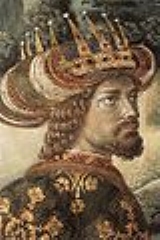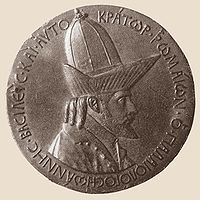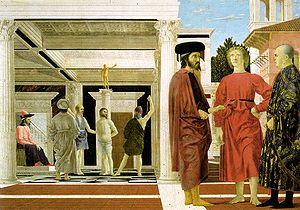
John VIII Palaiologos
Encyclopedia
John VIII Palaiologos or Palaeologus , was the penultimate reigning Byzantine Emperor, ruling from 1425 to 1448.
 John VIII Palaiologos was the eldest son of Manuel II Palaiologos
John VIII Palaiologos was the eldest son of Manuel II Palaiologos
and Helena Dragaš
, the daughter of the Serbia
n prince Constantine Dragaš
. He was associated as co-emperor with his father before 1416 and became sole emperor in 1425.
In June 1422, John VIII Palaiologos supervised the defense of Constantinople during a siege by Murad II
, but had to accept the loss of Thessalonica
which his brother Andronikos
had given to Venice
in 1423. To secure protection against the Ottomans, he visited Pope Eugene IV
and consented to the union of the Greek and Roman churches. The Union was ratified at the Council of Florence
in 1439 which John attended with 700 followers including Patriarch Joseph II of Constantinople
and George Gemistos Plethon, a Neoplatonist
philosopher influential among the academics of Italy
. The Union failed due to opposition in Constantinople
, but through his prudent conduct towards the Ottoman Empire
he succeeded in holding possession of the city.
John VIII Palaiologos named his brother Constantine XI
, who had served as regent in Constantinople in 1437–1439, as his successor. Despite the machinations of his younger brother Demetrios Palaiologos
his mother Helena was able to secure Constantine XI's succession in 1448.
John VIII died at Constantinople in 1448.
 He was married three times. The first marriage to Anna of Moscow
He was married three times. The first marriage to Anna of Moscow
, daughter of Grand Prince Basil I
of Moscow
(1389–1425) and Sophia of Lithuania
, in 1414. She died in August 1417 of plague.
The second marriage, arranged by his father Manuel II and Pope Martin V, was to Sophia of Montferrat
in 1421. She was a daughter of Theodore II, Marquess of Montferrat
and his second wife Joanna of Bar. Joanna was a daughter of Robert I, Duke of Bar and Marie Valois. Her maternal grandparents were John II of France
and Bonne of Bohemia
.
His third marriage, arranged by the future cardinal, Bessarion. was to Maria of Trebizond
in 1427. She was a daughter of Alexios IV of Trebizond
and Theodora Kantakouzene
. She died in the winter of 1439, also from plague. None of the marriages produced any children.
, on the southern wall of the Magi Chapel
, at the Palazzo Medici-Riccardi, in Florence
. According to some interpretations, John VIII would be also portrayed in Piero della Francesca
's Flagellation
. A portrait of John appears in a manuscript at the Monastery of St. Catherine at Sinai.
Life

Manuel II Palaiologos
Manuel II Palaiologos or Palaeologus was Byzantine Emperor from 1391 to 1425.-Life:...
and Helena Dragaš
Helena Dragaš
Helena Dragaš Helena was born to Constantine Dragaš of the noble House of Dejanović. Constantine was a Serbian provincial lord, ruling one of the principalities that emerged after the breakup of the Serbian Empire, centered at Velbăžd . Her mother was Constantine's unnamed first wife...
, the daughter of the Serbia
Serbia
Serbia , officially the Republic of Serbia , is a landlocked country located at the crossroads of Central and Southeast Europe, covering the southern part of the Carpathian basin and the central part of the Balkans...
n prince Constantine Dragaš
Constantine Dragas
Constantine Dragaš Dejanović was a Serbian magnate that ruled the area around Kyustendil from 1378, during the fall of the Serbian Empire, until his death on May 17, 1395 at the battle of Rovine...
. He was associated as co-emperor with his father before 1416 and became sole emperor in 1425.
In June 1422, John VIII Palaiologos supervised the defense of Constantinople during a siege by Murad II
Murad II
Murad II Kodja was the Sultan of the Ottoman Empire from 1421 to 1451 ....
, but had to accept the loss of Thessalonica
Thessaloniki
Thessaloniki , historically also known as Thessalonica, Salonika or Salonica, is the second-largest city in Greece and the capital of the region of Central Macedonia as well as the capital of the Decentralized Administration of Macedonia and Thrace...
which his brother Andronikos
Andronikos Palaiologos, Lord of Thessalonike
Andronikos Palaiologos or Andronicus Palaeologus was a Byzantine prince and the last Byzantine governor of Thessalonica with the title of despot , from 1408 to 1423....
had given to Venice
Republic of Venice
The Republic of Venice or Venetian Republic was a state originating from the city of Venice in Northeastern Italy. It existed for over a millennium, from the late 7th century until 1797. It was formally known as the Most Serene Republic of Venice and is often referred to as La Serenissima, in...
in 1423. To secure protection against the Ottomans, he visited Pope Eugene IV
Pope Eugene IV
Pope Eugene IV , born Gabriele Condulmer, was pope from March 3, 1431, to his death.-Biography:He was born in Venice to a rich merchant family, a Correr on his mother's side. Condulmer entered the Order of Saint Augustine at the monastery of St. George in his native city...
and consented to the union of the Greek and Roman churches. The Union was ratified at the Council of Florence
Council of Florence
The Council of Florence was an Ecumenical Council of the Roman Catholic Church. It began in 1431 in Basel, Switzerland, and became known as the Council of Ferrara after its transfer to Ferrara was decreed by Pope Eugene IV, to convene in 1438...
in 1439 which John attended with 700 followers including Patriarch Joseph II of Constantinople
Patriarch Joseph II of Constantinople
Joseph II was Patriarch of Constantinople from 1416 to 1439.Born the son of Ivan Shishman of Bulgaria in 1360, little is known of his early life before he became a monk on Mount Athos. He became Metropolitan of Ephesus in 1393, before being elected Patriarch of Constantinople on 21 May 1416...
and George Gemistos Plethon, a Neoplatonist
Neoplatonism
Neoplatonism , is the modern term for a school of religious and mystical philosophy that took shape in the 3rd century AD, based on the teachings of Plato and earlier Platonists, with its earliest contributor believed to be Plotinus, and his teacher Ammonius Saccas...
philosopher influential among the academics of Italy
Italy
Italy , officially the Italian Republic languages]] under the European Charter for Regional or Minority Languages. In each of these, Italy's official name is as follows:;;;;;;;;), is a unitary parliamentary republic in South-Central Europe. To the north it borders France, Switzerland, Austria and...
. The Union failed due to opposition in Constantinople
Constantinople
Constantinople was the capital of the Roman, Eastern Roman, Byzantine, Latin, and Ottoman Empires. Throughout most of the Middle Ages, Constantinople was Europe's largest and wealthiest city.-Names:...
, but through his prudent conduct towards the Ottoman Empire
Ottoman Empire
The Ottoman EmpireIt was usually referred to as the "Ottoman Empire", the "Turkish Empire", the "Ottoman Caliphate" or more commonly "Turkey" by its contemporaries...
he succeeded in holding possession of the city.
John VIII Palaiologos named his brother Constantine XI
Constantine XI
Constantine XI Palaiologos, latinized as Palaeologus , Kōnstantinos XI Dragasēs Palaiologos; February 8, 1404 – May 29, 1453) was the last reigning Byzantine Emperor from 1449 to his death as member of the Palaiologos dynasty...
, who had served as regent in Constantinople in 1437–1439, as his successor. Despite the machinations of his younger brother Demetrios Palaiologos
Demetrios Palaiologos
Demetrios Palaiologos or Demetrius Palaeologus , Despot in the Morea de facto 1436–1438 and 1451–1460 and de jure 1438–1451, previously governor of Lemnos 1422–1440, and of Mesembria 1440–1451...
his mother Helena was able to secure Constantine XI's succession in 1448.
John VIII died at Constantinople in 1448.
Marriages

Anna of Moscow
Anna Vasilievna of Moscow was the first wife of John VIII Palaiologos. She died while her husband was still the junior co-emperor of the Byzantine Empire.-Family:...
, daughter of Grand Prince Basil I
Vasili I of Russia
Vasiliy I Dmitriyevich was Grand Prince of Moscow from 1389.He was the oldest son of Dmitri Donskoi and Grand Princess Eudoxia, daughter of Grand Prince Dmitry Konstantinovich of Nizhny Novgorod.-Domestic policy:...
of Moscow
Moscow
Moscow is the capital, the most populous city, and the most populous federal subject of Russia. The city is a major political, economic, cultural, scientific, religious, financial, educational, and transportation centre of Russia and the continent...
(1389–1425) and Sophia of Lithuania
Sophia of Lithuania
Sophia was the only daughter of Vytautas the Great of Lithuania and his first wife Anna. On January 21, 1391, while her father was engaged in the Lithuanian Civil War, she married Vasili I of Russia. She was the longest serving consort of Russia.After his death in 1425 she became regent for their...
, in 1414. She died in August 1417 of plague.
The second marriage, arranged by his father Manuel II and Pope Martin V, was to Sophia of Montferrat
Sophia of Montferrat
Sophia of Montferrat was the second wife of John VIII Palaiologos. She was briefly the senior Empress consort of the Byzantine Empire.-Family:...
in 1421. She was a daughter of Theodore II, Marquess of Montferrat
Theodore II, Marquess of Montferrat
-Life:He was the thirdborn son of John II of Montferrat and Isabel of Majorca. Theodore was named governor of the margraviate after the death of his brother John III. After the death of John II, Montferrat had been plunged into a crisis brought on by the quick succession of two young rulers,...
and his second wife Joanna of Bar. Joanna was a daughter of Robert I, Duke of Bar and Marie Valois. Her maternal grandparents were John II of France
John II of France
John II , called John the Good , was the King of France from 1350 until his death. He was the second sovereign of the House of Valois and is perhaps best remembered as the king who was vanquished at the Battle of Poitiers and taken as a captive to England.The son of Philip VI and Joan the Lame,...
and Bonne of Bohemia
Bonne of Bohemia
Bonne of Luxemburg, Duchess of Normandy, Countess of Anjou and of Maine , was born Jutta , the daughter of John the Blind of Luxemburg, king of Bohemia and his first wife Elisabeth of Bohemia. She was the first wife of King John II of France; however, as her death occurred a year prior to his...
.
His third marriage, arranged by the future cardinal, Bessarion. was to Maria of Trebizond
Maria of Trebizond
Maria Megale Komnene , known as Maria of Trebizond was the third wife of John VIII Palaiologos. She was the last Empress consort of the Byzantine Empire.-Family:...
in 1427. She was a daughter of Alexios IV of Trebizond
Alexios IV of Trebizond
Alexios IV Megas Komnenos or Alexius IV , , Emperor of Trebizond from March 5, 1417 to October 1429. He was the son of Emperor Manuel III and Gulkhan-Eudokia of Georgia.- Reign :...
and Theodora Kantakouzene
Theodora Kantakouzene, wife of Alexios IV of Trebizond
Theodora Kantakouzene was the Empress consort of Alexios IV of Trebizond.-Family:Theodora and her relations are named in Dell'Imperadori Constantinopolitani, a manuscript held in the Vatican Library. The document is also known as the "Massarelli manuscript" because it was found in the papers of...
. She died in the winter of 1439, also from plague. None of the marriages produced any children.
Representation in art
He was famously depicted by several painters on the occasion of his visit to Italy. Perhaps the most famous of his portraits is the one by Benozzo GozzoliBenozzo Gozzoli
Benozzo Gozzoli was an Italian Renaissance painter from Florence. He is best known for a series of murals in the Palazzo Medici-Riccardi depicting festive, vibrant processions with wonderful attention to detail and a pronounced International Gothic influence.-Apprenticeship:He was born Benozzo di...
, on the southern wall of the Magi Chapel
Magi Chapel
The Magi Chapel is a chapel in Palazzo Medici Riccardi of Florence, Italy. It includes a famous cycle of frescoes by the Renaissance master Benozzo Gozzoli, painted in 1459-1461....
, at the Palazzo Medici-Riccardi, in Florence
Florence
Florence is the capital city of the Italian region of Tuscany and of the province of Florence. It is the most populous city in Tuscany, with approximately 370,000 inhabitants, expanding to over 1.5 million in the metropolitan area....
. According to some interpretations, John VIII would be also portrayed in Piero della Francesca
Piero della Francesca
Piero della Francesca was a painter of the Early Renaissance. As testified by Giorgio Vasari in his Lives of the Artists, to contemporaries he was also known as a mathematician and geometer. Nowadays Piero della Francesca is chiefly appreciated for his art. His painting was characterized by its...
's Flagellation
Flagellation of Christ (Piero della Francesca)
The Flagellation of Christ is a painting by Piero della Francesca in the Galleria Nazionale delle Marche in Urbino, Italy. Called by one writer an "enigmatic little painting," the composition is complex and unusual, and its iconography has been the subject of widely differing theories...
. A portrait of John appears in a manuscript at the Monastery of St. Catherine at Sinai.
Further reading
- Harris, Jonathan, The End of Byzantium. New Haven and London: Yale University Press, 2010. ISBN 978 0 30011786 8
- Nicol, Donald M., The Last Centuries of Byzantium. Cambridge: Cambridge University Press, 1993, 2nd edition. ISBN 0521 43991 4

